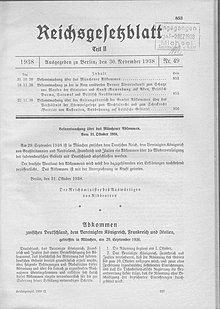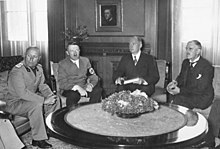Munich Agreement
![]()
This article explains the Munich Conference and the 1938 agreement. For the patent agreement signed in Munich in 1973, see European Patent Convention; for the Munich Conference on Security Policy, see there.
The Munich Agreement (official name: Agreement between Germany, the United Kingdom, France and Italy, reached in Munich, on 29 September 1938) was signed by the heads of government Adolf Hitler, Neville Chamberlain, Édouard Daladier and Benito Mussolini in the Führerbau in Munich on the night of 29-30 September 1938. Czechoslovakia and its allied Soviet Union were not invited to the conference. The agreement stipulated that Czechoslovakia had to cede the Sudetenland to the German Reich and vacate it within ten days. The invasion of the Wehrmacht began on October 1, 1938, and an international committee was to determine future borders and oversee referendums in additional areas. Similar provisions were made for the Polish and Hungarian minorities in Czechoslovakia. As a result of the agreement, Poland occupied the Teschen region on October 2, 1938. After bilateral talks, Hungary received territories in southern Slovakia and Carpathoukraine in the First Vienna Arbitration Award on November 2, 1938.
The Munich Agreement ended the Sudeten crisis. Hitler had deliberately escalated the conflict over the autonomy of the Sudeten Germans into an international conflict in which, according to his plan unfolded in the Hoßbach-Niederschrift, his aim was to isolate and ultimately break up Czechoslovakia. The Munich Agreement is considered the culmination of the Anglo-French policy of appeasement. The war in Europe that Hitler had wanted to provoke was prevented. Great Britain and France had already made it clear to the Czechoslovak government under Prime Minister Syrový on September 21, 1938, that it could not expect any assistance if the German demands were rejected. In order to avoid a war in which it would have stood alone against Germany, Czechoslovakia accepted the terms of the agreement. Because of the circumstances, the agreement is also called the Dictate of Munich.
Although the Munich Agreement appeared to be a great foreign policy success for National Socialist Germany, Hitler was dissatisfied because he had actually wanted to conquer all of Czechoslovakia. He subsequently stepped up his military-strategic and operational planning and on 15/16 March 1939, in breach of the Munich Agreement, had the so-called "Rest of Czechoslovakia" occupied.

Publication of the announcement on the Munich Agreement of 31 October 1938 in the Reich Law Gazette 1938, Part II, pp. 853 et seq.
Content
The Munich Agreement decreed that Czechoslovakia was to cede its border areas, the Sudeten German territories, which were predominantly inhabited by Germans, to the German Reich immediately. It had come about after the deliberations of the heads of government of the four Great Powers, Chamberlain, Daladier, Hitler, and Mussolini, in the Führerbau in Munich, and was signed by them there at 1:30 a.m. on September 30, 1938. In additional declarations they laid down further modalities. In return for the cession, Great Britain and France promised Czechoslovakia the protection of an international guarantee. Germany and Italy also promised a guarantee, subject to a settlement of the question of Polish and Hungarian minorities in Czechoslovakia. However, an international guarantee never materialized.
The agreement only determined the principles of evacuation, border determination and nationality regulation. The implementation of the agreement on the cession of the Sudetenland, the determination of the borders and the modalities of the evacuation were to be regulated by a committee of the signatory states. It was also to determine in which areas referendums were to be held, on the model of the Saar referendum of 1935. A right of option for the population was provided for.
The Czechoslovak Government should send a representative to this international committee. A German-Czechoslovak committee was to make arrangements for optants to enable them to change territory into or out of the ceded territories. Czechoslovakia was not involved in the conference itself.
Meaning
The Munich Agreement effectively meant the end of the multinational Czechoslovakia that had emerged in 1918, since the neighbouring states of Poland and Hungary also took advantage of the opportunity to occupy territory, but unlike Germany without the consent of the signatory powers Great Britain and France. The latter showed understanding only late for the wish of the Sudeten German population, which had been ignored since 1919, and therefore regarded this decision as a partial revision of the Treaty of St. Germain or as a subsequent fulfilment of the peoples' right to self-determination. First and foremost, they wanted to prevent a war. They hoped to guarantee the continued existence of the Czechoslovak state by means of an appeasement policy and thus to fulfil the mutual assistance agreement.
As a result, with the exception of France, all the other Great Powers had regarded and treated the Munich Agreement as validly concluded by 1942; only France subsequently specified its position of wanting to regard the Agreement as null and void ab initio; "on the other hand, the British Government holds with great firmness the legal position it has always taken, namely that the Munich Agreement was validly concluded at the time, was legally binding for a time, but has since become invalid with effect ex nunc as a result of the conduct of the German Reich".

Munich Conference on 29 September 1938 in the Führerbau on Königsplatz in Munich, from left to right: Mussolini, Hitler, interpreter Paul Otto G. Schmidt, Chamberlain
Search within the encyclopedia